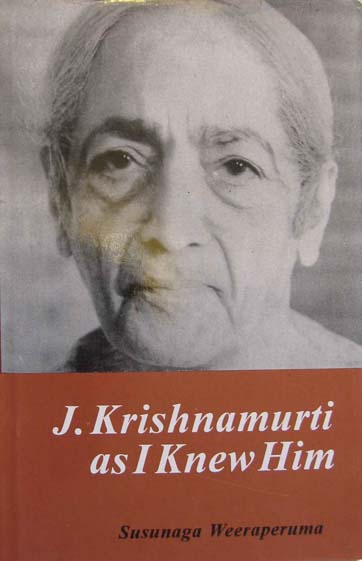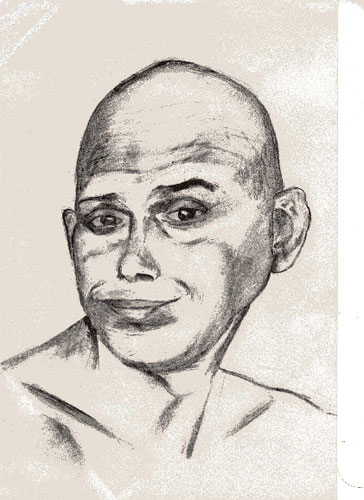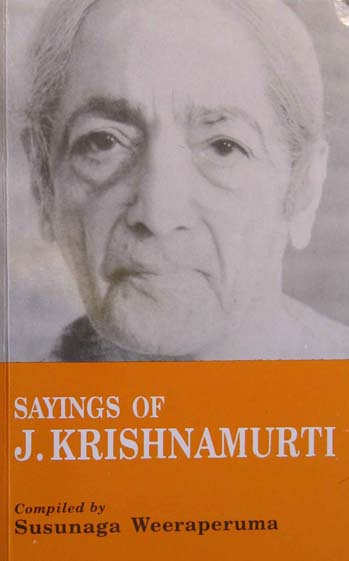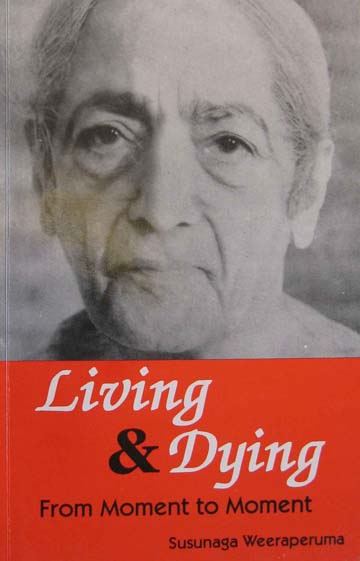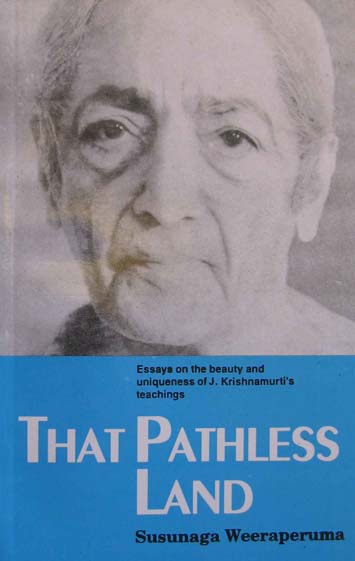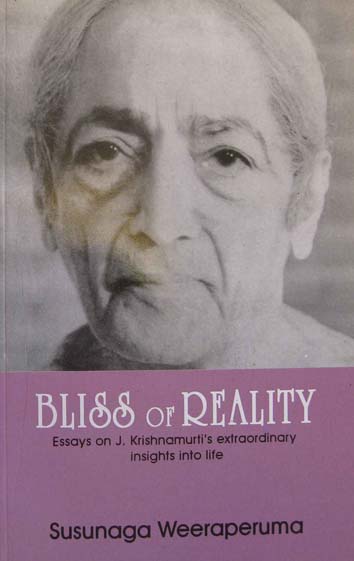 |
J. Krishnamurti |
 |
|
Living and Dying from Moment to Moment Jiddu Krishnamurti: A Bibliographical Guide
|
|
New Delhi: Motilal Banarsidass |
J. Krishnamurti as I Knew Him is a fascinating description of Krishnamurti's unique personality by Susunaga Weeraperuma, who was not only closely associated with him but also enthusiastically involved in his worldwide activities for some 30 years.
Abounding in hitherto unpublished statements by K on various subjects, this work is an invaluable source of information on the life and teachings of this extraordinary sage. The author has written long accounts of his many private meetings and interviews with K and has narrated numerous anecdotes of K's life and even quoted some of his jokes and casual remarks, all of which make the book highly interesting.
Intelligence is the Only Security
One afternoon we noticed the presence of an unexpected visitor at the entrance to the house. He was a beggar in rags, who was carrying a drum and a stringed instrument. I gave him a few rupees and requested him to sing some Sinhalese folk songs. He started singing cheerfully and loudly with the result that K opened his bedroom window and leaned forward to hear the melodious chants. K listened with rapt attention for half an hour. It surprised us very much when K suddenly appeared and affectionately hugged the beggar. K thanked the poor man and presented him with a clean white towel and a pair of pyjama trousers that belonged to him. This was not the first occasion when I had seen such acts of spontaneous generosity on the part of K. Soon after the beggar's departure, my friend, Mr Abeysekara, conversed with K in the lounge downstairs:
A: If we have rightly understood your teachings, shouldn't we all end up as beggars ourselves?
K: Physical security must not be confused with psychological security. We all need decent clothes, the right food and a roof above our heads, don't we? That kind of security is essential to keep the body healthy. But do we need the satisfaction of having so many gods and idols and beliefs? So when you seek psychological security in this way, you are chasing illusions, aren't you?
A: You have said that intelligence is the only security.
K: That's right. So try throwing off all your attachments.
A: Being a beggar and walking the streets is not at all easy. No proud person would be prepared to beg. I would like to become a beggar because having to beg for my needs will teach me humility.
K: Humility cannot be acquired by behaving like a beggar. Humility cannot be cultivated by the cunning intellect. Just see that it is your pride which says “I want to be humble”. The carefully cultivated humility of the religious people is really a disguised form of pride. So what is important is seeing yourself as you are, right now, seeing the fact of what is, without bothering about what should be.
The Enigma that was J. Krishnamurti
Being in a permanent and continuous state of samadhi is the traditionally accepted hallmark of Self-realised persons. Their samadhi is always continuous; it is never occasional. It is not experienced intermittently. Variously described as “the otherness”, “the intensity” or “the immensity” in Krishnamurti's writings, his samadhi came to him by fits and starts. All the evidence points towards the fact that his states of samadhi were short-lived: “Very early this morning, many hours before dawn, on waking there was that piercing intensity of strength with its sternness. There was in this sternness, bliss. By the watch it 'lasted' for forty-five minutes with increasing intensity. The stream and the quiet night, with their brilliant stars, were within it. “Every thought, every feeling was gone and the brain was utterly still... And of a sudden that unknowable immensity was there, not only in the room and beyond but also deep, in the innermost recesses, which was once the mind.” During those periods when K was not overpowered by “the otherness” he behaved like an ordinary human being in the sense that he was subject to states of fear, anxiety, shyness, irritability and depression. Yet he was an exceptional person because he was almost devoid of envy, hate or violence. Before giving public talks K used to feel shy and nervous. But when swayed by “the otherness” his personality changed noticeably, especially in the act of delivering a discourse. His diffidence temporarily disappeared and he always spoke like a man under the influence of an unseen power. Then he would seem to be in a trance and words of wisdom flowed from his lips. Often, after a discourse, he had no recollection of what he had just been saying. Immediately after fulfilling his special mission as a spiritual teacher, K would revert to the psychological state of an ordinary human being. It is a pity that K's biographers have overlooked the fact that he had this dual personality. They have failed to understand that most of the time K behaved like any ordinary mortal and a very loveable one at that; but at other times, he became a human channel for the manifestation of the divine “otherness”.
|
 |
Do Self-realised persons experience the state of being united with Brahman only temporarily or permanently? Ramana Maharshi remarked that “a person who has been going about in the sun feels cool when he reaches the shade. Someone who keeps on going from the shade into the sun and then back into the shade is a fool. A wise man stays permanently in the shade. Similarly, the mind of the one who knows the truth does not leave Brahman. The mind of the ignorant, on the contrary, revolves in the world, feeling miserable, and for a little time returns to Brahman to experience happiness. In fact, what is called the world is only thought. When the world disappears, i.e. when there is no thought, the mind experiences happiness; and when the world appears, it goes through misery.”
Thought, according to K, cannot heal any psychological wounds because thought is itself the wound. Thought cannot liberate us because thought is itself the main obstacle to Liberation. K said: “Is not Reality ever the uncreated? And must not the mind cease to create, to formulate, if it would experience the Uncreated?” Reality, then, is to be found in the interval between two thoughts. So long as man remains enslaved to thought, and conditioned by thought, he can never find that indescribable, unconditioned state of bliss. The mind is incapable of transcending its own frontiers. Hence, however hard the mind tries to improve itself through various kinds of disciplines, practices and sadhanas, such actions will be of no avail. Yet, K contradicted himself by insisting that unless spiritual aspirants work very hard they will never succeed in discovering the Absolute. Now, is it really possible to work without exercising the mind at all? Any resort to effort necessarily involves the use of the conditioned mind. K distrusted thought to such an extent that he urged us never to use it for a spiritual purpose: “You may not invite Reality, it must come to you; you may not choose Reality, it must choose you.” After having likened Reality to a kind of grace, he still wanted us to work hard. The problem is that the moment I involve myself in any activity that is directed towards my spiritual upiftment I have found that I invariably activate the thought process.
K and Ramana differed widely on the question of the usefulness of thought as a means of attaining union with the Absolute. According to K the mind can never think accurately about God. Such thinking can only result in the formation of mere opinions and beliefs that have no relationship whatsoever to the actuality of God. Why be satisfied with a concept of God that is only a fictitious creation of the imagination? But Ramana taught that thinking of the Self is not without value: “He who gives himself up to the Self that is God is the most excellent devotee. Giving one's self up to God means remaining constantly in the Self without giving room for the rise of any thoughts other than the thought of the Self.” One is heartened by the fact that Ramana did not view thought in black and white terms. Like nuclear energy, thought can be immensely destructive if wrongly used but equally it is capable of elevating us to the very threshold of divinity. K urged his listeners to be constantly aware of their thoughts and feelings without in any way condemning or justifying them. The wandering of the mind can be ended by thinking through, and feeling to the end, every thought-feeling. Such awareness involves the avoidance of judging or evaluating one's stream of consciousness. During the 1940s he advocated an effortless and passive awareness. Many persons who experimented on this themselves complained that such a method was not only arduous but also failed to liberate them. Then in 1956 K contradicted himself: he stated that total awareness cannot be maintained all the time. He therefore suggested a minute or two of total awareness followed by a period of relaxation, during which one can observe the operations of one's mind. Awareness is central to K's teachings. Although he insisted upon awareness as the means of transcending the limitations of the mind and arriving at the discovery of Truth (despite his contradictory dictum that 'Truth is a pathless land'), it is doubtful if any of his listeners actually found Liberation. The countless thousands in various countries who listened to K got nowhere. By observing their thought processes for years they found that they were becoming increasingly enmeshed in thought. Instead of their minds becoming dissolved, they realised to their dismay that they were becoming more and more cerebral.
K maintained that it is thought that creates the thinker. The “I” is merely a fictitious invention of thought. Hence the dissolution of thought automatically results in the dissolution of the “I”. K's teaching in this regard was diametrically opposed to that of Ramana who said: “Of all the thoughts that arise in the mind, the “I” thought is the first. It is only after the rise of this that the other thoughts arise.” |
Ramana Maharshi (1879 - 1950) |
Much more important than the question of the origin of thought is that of its ending. K refused to prescribe any methods or techniques for this purpose. He said that thought will end of and by itself when there is full understanding of the thought process. Presumably, this faculty of understanding comes into being when the mind is free of thought. Is it any help to be told that one comes by this no-thought state, and that it occurs accidentally, without any exertion of effort?
I was closely associated with K and his worldwide activities for more than three decades. His human and endearing qualities as well as his siddhis (supernatural faculties) have been described in this work J. Krishnamurti as I Knew him. Although his mind was extraordinarily clear and profound, one is puzzled by the fact that K was also a confusing bundle of contradictions. The task of reconciling the different sides of his enigmatic personality is not easy. It is for the reader to discover, if possible, any elements of unity and harmony that may underlie the contradictions listed below.
In the Asian world it is generally the case that the lives of saints are characterised by a certain simplicity and austerity. Although K advocated simple living, he actually led a life of luxury amidst the rich and famous. He was always the darling and protégé of the wealthy and privileged. K wore beautifully tailored suits and only handmade shoes pleased him. What a contrast to Ramana and all the other sages of his lineage who were content with a mere loincloth! He also enjoyed travelling in high-powered motor cars. Indeed his passion for cars was legendary. Surrounded though he was by material possessions, it is significant that he was indifferent to them. He was somehow not attached to the things of this world and was always ready to give away any of his belongings to those in need.
With all the rhetoric that he could muster, K denounced the activities of all gurus whom he likened to exploiters of the gullible. He insisted on absolute self-reliance in spiritual matters. Those who are confused, acting out of their own confusion, cannot but select gurus who are also confused. The clear-sighted need no gurus, he argued, because they are lights unto themselves. That may be so but how many have that rare clarity which characterises the enlightened? By denouncing all gurus was he not doing an injustice to that minority of Self-realised gurus who are really genuine? By casting aspersions on other teachers was he not subtly promoting his own teachings? Although he severely criticised the institution of the guru, was he not himself, to all intents and purposes, a kind of guru? K did not of course have a beard and wear saffron coloured clothes but he was the spiritual instructor to thousands of his admirers. Like any other guru, K counselled numerous persons who had psychological problems. To the distressed he privately prescribed sadhanas despite his publicly declared opposition to all spiritual practices.
K rebuked photographers who tried to take pictures of his radiant face. But he did not mind being photographed by specially selected persons. Towards the end of his life there was even an official photographer! He tried to create the impression that he disapproved the glorification of his personality. Yet he permitted the use of his name for the establishment of various foundations, information centres and schools. He soon became the expositor of a body of teachings which gave rise to a cult. The followers of K resent the word 'guru' but is he not a respected father figure to them?
All ashrams were held in abomination by K. He stated that meditation, which is a voyage of self-discovery, should be done individually and never within the restrictive presence of a body of persons. So he described group meditation as a “vulgarity”. He regarded ashrams as “concentration camps” where the mind is subjected to conditioning influences. Nevertheless, K was responsible for initiating several educational centres where students and teachers are expected to devote much time to self-observation while living communally. During his lifetime K regularly guided his followers at these centres which are really ashrams in essence.
Organised religions and other spiritual organisations were vehemently condemned by K. So in 1929, after 18 years of its existence, K dissolved his own Order of the Star. It was a bold act that resulted in thousands of his disciples feeling lost and leaderless. After declaring that “my only concern is to set men absolutely, unconditionally free”, why did he later in life (in the 1960s) establish several Krishnamurti Foundations in the world? What he did was clearly inconsistent with his earlier opposition to such organisations. Many of his friends were disillusioned with him. There were some who kept away from his talks as a token of protest. K's reputation for integrity was severely shattered and the situation worsened when some of the trustees of his organisations started misusing their powers. Vast sums of money were collected in his name and at the time of his death in 1986 these wealthy organisations were rife with intrigues and power struggles. What had originally been a pure teaching, with its emphasis on self-reliance and self-observation with a view to the purification of the mind, was sadly vitiated by the lure of gold and real estate. That was the unfortunate aspect of K's legacy.
The only explanation of K's strange behaviour is that he was easily influenced by those around him. His mind was so malleable that it was easily bent by unscrupulous people to their advantage. It was this quality of innocent openness that helped to make him a superb medium. We shall return to this theme later in this essay.
When Bishop Leadbeater discovered the boy K, the Theosophists were quick to recognise the youngster's vacant mind, with its enormous spiritual potential. He had a certain vagueness and openness and all the makings of a marvellous medium. So they declared that K was destined to be the “Vehicle of the World Teacher”. It is to be noted that K was going to be only the chosen vehicle, the medium or spokesman of the Lord Maitreya, the future Buddha, and not the great Teacher himself. Like the Prophet Mohammed, his role was that of a mere messenger. Messengers of God have to be faithful reporters of the sacred word but do not necessarily have to be divine themselves.
When K was asked whether he was in fact the World Teacher, he evaded the question by saying that it is the teachings that are important and not the label or designation given to the person who expresses them. What matters is the song and not the name of the singer. However K never denied his special destiny. He was deeply conscious of his extraordinary mission in life despite his repeated denials of having any image of himself.
Was K just an ordinary human being most of the time, who sometimes gave expression to divine messages? If we accept this possibility, as certain Theosophists do, it helps considerably to understand K's dual nature. It explains his many contradictions.
No account of K is complete without a reference to his great compassion for all beings. He loved all equally but he seemed to have favourites. He was seriously concerned about the problem of human suffering and sincerely felt that it was his personal responsibility to alleviate it. His boundless love even extended to the wild animals he met in the course of his solitary walks in jungles and other places. He had no fear of dangerous animals and in this respect he was like Ramana. Buddhists believe that compassion will be the predominant feature of the future Maitreya Buddha. It is indeed significant that K was an embodiment of loving kindness; it is also noteworthy that his teachings have a Buddhist flavour. Was he then a harbinger of the future Enlightened One?
As a young man K composed mystical poems. What follows is an excerpt from one of his poetical works titled The Immortal Friend wherein K describes a vision he had --- a vision of the Buddha.
I sat a-dreaming in a room of great silence. The early morning was still and breathless, The great blue mountains stood against the dark skies, cold and clear, Round the dark log house The black and yellow birds were welcoming the sun. I sat on the floor, with legs crossed, meditating, Forgetting the sunlit mountains, The birds, The immense silence, And the golden sun. I lost the feel of my body, My limbs were motionless, Relaxed and at peace. A great joy of unfathomable depth filled my heart. Eager and keen was my mind, concentrated. Lost to the transient world, I was full of strength. As the Eastern breeze That suddenly springs into being And calms the weary world, There in front of me Seated cross-legged, As the world knows Him In His yellow robes, simple and magnificent, Was the Teacher of Teachers. Looking at me, Motionless the Mighty Being sat. I looked and bowed my head, My body bent forward of itself. That one look Showed the progress of the world, Showed the immense distance between the world And the greatest of its Teachers. How little it understood, And how much He gave. How joyously He soared, Escaping from birth and death, From its tyranny and entangling wheel. Enlightenment attained, He gave to the world, as the flower gives Its scent, The Truth. As I looked At the sacred feet that once trod the happy Dust of India, My heart poured forth its devotion, Limitless and unfathomable, Without restraint and without effort. |
That K had certain shortcomings was a matter of considerable sadness to the countless thousands who adored him. Was he inwardly a fully transformed spiritual master, despite all the imperfections that were evident in his outward behaviour? Who am I to judge? Perhaps it is best to ignore his personality, forget the man K who is no more, and concentrate instead on the marvellous spiritual teachings that were given to the world through him.

click on the flowers to go up to the menu
|
compiled by Susunaga Weeraperuma New Delhi: Motilal Banarsidass
|
In May 1985 Sri J. Krishnamurti very kindly invited me for lunch at Arya Vihar, his home in Ojai, California. This was a memorable occasion as it occurred only a few days after his 90th birthday. After a delicious vegetarian meal I informed Krishnaji that I was planning to compile for publication an anthology of quotations from his writings. He then inquired whether this book was going to be like The Perennial Philosophy by his late friend, Aldous Huxley. I replied that it would be similar to Huxley's compilation in some respects but I would be selecting shorter passages and pithy sentences for inclusion. Then our discussion turned to the problem of finding a suitable title for the book. I suggested the title 'The Wisdom of Krishnamurti'. Krishnaji said: “That's too grand! Why not call it Sayings of Krishnamurti?”. That he preferred a simple title to a grand one is so typical of his modest and self-effacing character.
This book is nothing more than a collection of his sayings up to the year 1968.
Like a beautiful garland of many fragrant flowers, these selections have been taken from his utterances on a wide range of spiritual and philosophical subjects. I have painstakingly tried to present in this volume the quintessence of the message of one of the greatest teachers of all time.
At the end of every quotation is a statement indicating its source. In this way the interested reader is helped not only to check the authenticity of a quotation but also its context.
It is hoped that those who come upon this volume would be stimulated to read and study Krishnamurti's own works of which fortunately there are a great many in existence. Those who discover his books will find that they open a door to a new world, a new approach to life and a heightened sensitivity.
This book is the first one of its kind ever to be published relating to the teachings of Krishnamurti. It is a collection of 514 of his sayings that are alphabetically arranged like a dictionary under 118 different subject headings. This invaluable reference book helps one to find out quickly what Krishnamurti has said on important subjects.
Silence
“Between two thoughts there is a period of silence which is not related to the thought process. If you observe you will see that that period of silence, that interval, is not of time; and the discovery of that interval, the full experiencing of that interval, liberates you from conditioning --- or rather, it does not liberate 'you', but there is liberation from conditioning.”
Krishnamurti's Talks 1949-1950 (Verbatim Report)...India p.74
click on the flowers to go up to the menu
|
Living and Dying From Moment to Moment New Delhi: Motilal Banarsidass
|
The French writer René Fouéré observed that this “book is very remarkable and well-written. In it he speaks very clearly on the most important matters treated by Krishnamurti in his teachings year after year. The author has a sharp insight into human psychology, and his art of expressing it in a simple and striking manner deserves the best compliments. He has conveyed very faithfully the thought of Krishnamurti in this work, which, I am sure will give its readers a precious opportunity to become aware of the subtle and deceitful intricacies of their own mind. This book constitutes both an excellent introduction as well as an incentive to the reading of Krishnamurti's works.”
Weeraperuma's writings on the mechanics of awareness, so to speak, do help to enhance the value of this book:
“What is involved in dying psychologically from moment to moment? When each thought and feeling is fully experienced, and not just partially, the image building process ends of its own accord. Such an ending can never take place unless each image is fully explored, fully experienced, fully understood and therefore fully discarded. Do we ever care to look at our images and stay with them? Looking at an image implies going to the very roots of it; staying with an image implies the honest acceptance of it: there is no desire to change or run away from the image.”
“Images that have not been understood fully in the light of awareness tend to reappear in dreams. Images that fail to find expression during our so-called waking state of consciousness eventually get released in our so-called sleeping state of consciousness. Some have carelessly classified consciousness into states of waking, dreaming, sleeping and so forth. Actually there is hardly any significant difference between our supposed waking state on the one hand and the states of dreaming and sleeping on the other. Surely it is the absence or presence of images that indicates whether one is awake or fast asleep. The mind that is engrossed in images, either while being 'awake' or asleep, is really in a state of deep slumber, but the mind that is not preoccupied with images is truly and supremely awake.”
“Every night before falling asleep I review the day's events. This is neither a kind of introspection nor self-analysis but a quick scanning of some of the various images that have entered consciousness. It is like playing back the film of recorded images on the screen of awareness. Admittedly such a review is not without snags for many of the images that are deserving of a more searching observation would have long been lost and forgotten. Yet in the comparative peace and quietness of one's bed one has an opportunity of looking more fully at some at least of the numerous images that slipped by swiftly during the day when one was either too tired or too busy to be more thoroughly aware. It should be made clear however that such a scanning of images is never a substitute for the intensive observation of the image-making process: it is awareness alone that results in the dying of images at the very moment of their birth.”
“Psychological images that do not die get reborn again and again, either during sleep or when the conscious mind is comparatively quiet. There is freedom from this bondage of rebirths only when images die at the very moment of their inception. Is there any greater virtue than that of dying to all one's accumulated hates, jealousies, rivalries and prejudices? Living and dying are inseparable : it is by dying from moment to moment that one discovers the only life worth living --- the imageless, deathless life of spiritual liberation.”

click on the flowers to go up to the menu
|
Essays on the beauty and uniqueness of J. Krishnamurti's teachings
|
The author reveals his experiments with self-inquiry, which is in the spirit of J. Krishnamurti's teachings, yet authentically his own. This books also deals with various important aspects of the “phenomenon” that is J. Krishnamurti --- a topic of everlasting fascination to many people all over the globe.
“After capturing a fleeting glimpse of that blissful state of no-self, the mind tends greedily to record an impression of it which then becomes part and parcel of consciousness. Because the acquisitive mind starts cherishing that memory there naturally arises a longing to experience that state again and again. Nostalgia is the bane of the mind. As the mind failed to renew itself by dying to that remarkable experience and thereby dropping it once and for all, it now finds itself far less open to the possibility of once again entering that extraordinary dimension of no-self.”

click on the flowers to go up to the menu
|
Essays on J. Krishnamurti's extraordinary insights into life
New Delhi: Motilal Banarsidass |
The fascinating and incisive essays that comprise this book were inspired by Krishnamurti's statements on Life's fundamental questions. Some of the topics covered are “Why believe in God?”, “Why believe in reincarnation?”, “Is dreamless sleep possible?” and “Does naming hinder the Nameless?”.
“The book is the outcome of a very careful examination of the teachings: it is not an interpretation of Krishnamurti's statements on life's deepest questions, but purely a searching investigation of them. I have looked at the teachings closely and critically, without interpreting them... I have not foisted into them any ideologies or beliefs.”
“This work is also the account of explorations into my own mind and heart: it is, in other words, the record of experiments with awareness.”
“Upon rising after one of those rare spells of dreamless sleep, one feels astonishingly refreshed in both body and mind. The rejuvenation of the mind, and its beneficial impact on the body, is very noticeable. There is a great sense of renewal, peace and joy. Then, with the senses sharpened, one suddenly sees the world afresh, as though for the first time, through the eyes of a newly born babe. But soon the mind starts talking to itself again, with the intention of safeguarding and prolonging that gladness, and consequently the short-lived feeling of extreme personal well-being fades away, like the early morning dew that is quickly gone.”

click on the flowers to go up to the menu
|
Jiddu Krishnamurti : A Bibliographical Guide, compiled by Susunaga Weeraperuma New Delhi: Motilal Banarsidass
|
The bibliographical information presented herein has been embellished in many places with numerous quotations. These aphoristic passages contain the gist of a book or an article; the sheer beauty and depth of Krishnamurti's pithy sayings warranted their inclusion.
There are, in addition, selected extracts from certain rare works by other writers because these are now either out-of-print or seldom available even in well-stocked libraries and archives.
click on the flowers to go up to the menu

